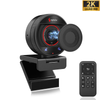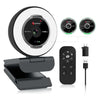What Do I Need to Cast a Google Meet on a Smart TV?
von {{ author }} Angetube an Dec 14, 2023

In today's fast-paced digital world, the ability to connect and collaborate effectively is paramount. Google Meet has emerged as a popular tool for virtual meetings, and integrating it with a smart TV enhances the experience. This article delves into the nuances of casting Google Meet on a smart TV, providing insights and guidance for a seamless setup.
Google Meet's versatility makes it a go-to choice for both professional and personal interactions. By casting it on a smart TV, users can enjoy larger displays, making meetings more engaging and visually appealing.
Mastering the Art of Google Meet on Your Smart TV
In today's digital age, where remote work has become the norm, mastering virtual communication platforms like Google Meet is essential. For home workers looking to enhance their video conferencing experience, casting Google Meet on a Smart TV is an innovative solution. This guide details the essential requirements and steps to seamlessly integrate Google Meet with your Smart TV, ensuring an immersive and professional virtual meeting experience.
1. Smart TV Compatibility: The Starting Point
The first step is to ensure your Smart TV is compatible with casting technologies. Most modern Smart TVs come equipped with built-in casting capabilities like Chromecast or support external casting devices. Check your TV’s specifications or user manual to confirm its compatibility.
2. Reliable Internet Connection: The Backbone of Streaming
A stable and high-speed internet connection is paramount. Video conferencing, especially on a larger screen like a Smart TV, requires robust bandwidth to maintain high-quality video and audio without lag or interruption.
3. Casting Device: Bridging the Gap
If your Smart TV doesn’t have built-in casting functionality, investing in a casting device is necessary. Devices like Google Chromecast or Apple TV can be easily connected to your TV and enable streaming from various devices.
4. Google Meet Setup: Ensuring Compatibility
Ensure that your device (smartphone, tablet, or computer) has the latest version of the Google Meet app or is updated with the latest web browser version if you’re using a laptop or desktop.
5. Google Account: Your Access Key
A Google account is required to use Google Meet. Make sure you are logged into your account on the device you plan to cast from.
6. Seamless Integration: Casting Google Meet to TV
Once all requirements are met, open Google Meet on your device and start or join a meeting. Use the casting feature on your device to connect to your Smart TV. For Chromecast users, this can be done through the Google Home app.
7. Audio and Video Quality: Fine-Tuning for Clarity
Adjust the settings on your Smart TV to ensure optimal video and audio quality. Consider the acoustics of your room and the placement of your Smart TV to enhance sound clarity.
8. Testing Before the Meeting: A Crucial Step
Conduct a test run before any important meeting to troubleshoot potential issues with connectivity, audio, or video quality.
9. Privacy and Security: Safeguarding Your Meetings
Ensure your Wi-Fi network is secure, and consider using a VPN for additional security. Always keep your devices and apps updated to the latest security standards.
10. Ergonomics: Comfort During Long Meetings
Since you’ll be looking at the TV screen, ensure your seating arrangement is comfortable and doesn’t strain your neck or eyes. Adjust the lighting in the room to reduce glare on the TV screen.
Optimizing Google Meet Live Stream for Effective Workplace Communication
In the dynamic world of work, live streaming has become a key communication tool, and Google Meet is at the forefront of this revolution. Understanding how to initiate and enhance a Google Meet live stream is essential for workers aiming to facilitate effective and engaging online interactions. This detailed guide will walk you through the steps to start a live stream on Google Meet and provide tips to enrich your live streaming experience.
Initiating a Google Meet Live Stream: A Step-by-Step Guide
1. Accessing Google Meet:
Firstly, ensure you have a Google account, as this is necessary to access Google Meet. You can start a live stream either through the Google Meet website or the mobile app, offering flexibility for different user needs.
2. Starting Your Meeting:
On the Google Meet homepage, click on 'New Meeting' to start a new live session. You have the option to immediately begin the meeting or schedule it for a later time, which can be beneficial for planned events.
3. Inviting Participants:
After setting up your meeting, it's time to invite participants. Google Meet allows you to easily send invitations via email directly from the meeting interface. To maintain the security of your meeting, share this information only with the intended audience.
4. Enabling the Live Stream Feature:
To activate live streaming, navigate to your meeting’s settings and select the 'Live Streaming' option. Keep in mind that this feature might be available only with certain Google Workspace accounts. Follow the on-screen instructions to finalize your live stream setup, including adding a descriptive title and a brief description.
5. Going Live:
With everything in place, click on ‘Start Streaming’. Be aware that there could be a brief delay as the live stream becomes active, so plan the beginning of your session accordingly.
Tips for Enhancing Your Google Meet Live Stream Experience
1. Stable Internet Connection:
A strong and reliable internet connection is crucial for a smooth live streaming experience, ensuring uninterrupted video and audio transmission.
2. High-Quality Audio and Video:
Invest in a quality webcam and microphone to ensure your live stream has clear visuals and sound, which are key to maintaining audience engagement.
3. Proper Lighting:
Good lighting can significantly improve the quality of your live stream. Natural lighting is ideal, but if that's not possible, use soft, artificial lighting sources to avoid harsh shadows and glares.
4. Interactive and Engaging Content:
Make your live stream interactive by incorporating visual aids, such as slides or screen sharing. This can make the content more engaging and informative for your audience.
5. Audience Engagement:
If your live stream format allows, interact with your audience by encouraging questions and comments. This interaction can make the live stream more dynamic and engaging.
6. Creating a Professional Environment:
Ensure your streaming environment is quiet and free from distractions. This helps maintain a professional atmosphere during your live stream.
7. Rehearsal and Preparation:
Practice your presentation before going live. This helps identify and resolve any potential technical or content-related issues.
8. Post-Stream Follow-Up:
After the live stream, consider sending a summary email or additional resources to your audience, especially if there were questions you couldn’t address during the session.
Advanced Features
In the digital age, where video communication is vital, leveraging advanced features like Google Meet Live Stream on YouTube can significantly enhance the online presence of workers in various fields. This comprehensive guide aims to navigate you through the intricacies of using Google Meet for live streaming on YouTube, and how to optimize these settings for maximum impact.
Integrating Google Meet with YouTube for Live Streaming
1. Understanding the Prerequisites:
To stream Google Meet on YouTube, you need a verified YouTube account. This verification process is straightforward and essential for unlocking the live streaming feature on your YouTube channel.
2. Setting Up Google Meet:
Ensure that you have access to Google Meet and that your account is equipped to initiate a live stream. This feature is typically available with certain Google Workspace accounts.
3. Initiating a Live Stream on Google Meet:
Start by scheduling a new meeting on Google Meet. Go to the 'Activities' option and select 'Live Streaming'. You'll be prompted to set up your live stream, including entering the stream's title and description.
4. Connecting Google Meet to YouTube:
In your YouTube Studio, create a new live stream. Copy the 'Stream Key' from YouTube and paste it into the respective field in your Google Meet live stream setup. This key is what links your Google Meet to your YouTube stream.
5. Going Live:
With the connection set up, start your Google Meet call and then go to YouTube to start the live stream. Ensure you monitor both platforms to manage the stream effectively.
Optimizing Live Stream Settings for YouTube
1. Selecting the Right Streaming Quality:
YouTube offers various streaming qualities. Choose one that suits your internet bandwidth. A higher quality stream (like 1080p) offers better clarity but requires a stronger internet connection.
2. Managing Audio Settings:
Ensure your microphone settings are optimized for clarity. Consider using an external microphone for enhanced audio quality, especially in environments with background noise.
3. Enhancing Video Quality:
Good lighting and a high-quality camera can significantly improve your video feed. Position your lighting to avoid shadows and glare for the best visual output.
4. Preparing Content for Your Audience:
Plan your content to be engaging and interactive. Use tools like screen sharing or presenting slides to make your live stream more dynamic and informative.
5. Interacting with Your Audience:
Engage with your viewers through YouTube's chat feature. Acknowledging comments and questions can make the stream more interactive and engaging.
6. Testing Your Setup:
Before going live, conduct a test run to check audio, video, and internet stability. This helps in identifying and rectifying any issues in advance.
7. Promoting Your Live Stream:
Promote your live stream in advance through social media or email newsletters to garner a larger audience. Provide clear information about the time and topic of the stream.
8. Following YouTube Guidelines:
Adhere to YouTube's community guidelines to avoid any disruptions in your live stream. Familiarize yourself with these guidelines to ensure a smooth streaming experience.
Comparisons
In the ever-evolving landscape of digital communication, understanding the distinct features and functionalities of platforms like Google Live Stream and Google Meet is vital for workers striving to choose the right tool for their professional needs. This concise guide aims to demystify the differences between these two platforms, helping you make an informed decision for your next virtual event or meeting.
Google Live Stream vs Google Meet: Unraveling the Differences
1. Purpose and Audience Engagement:
- Google Live Stream: Primarily designed for broadcasting events to a large audience. It’s ideal for webinars, large-scale presentations, or company-wide announcements. The focus is on one-way communication from the broadcaster to the audience.
- Google Meet: Tailored for interactive video conferencing. It’s perfect for team meetings, collaborative sessions, or small-scale workshops where two-way communication and participant engagement are key.
2. User Capacity:
- Google Live Stream: Can accommodate a vast number of viewers, making it suitable for large audiences without compromising the quality of the broadcast.
- Google Meet: Generally supports a limited number of participants (up to 250 in some plans), ensuring a more intimate setting for discussions and collaborations.
3. Interactivity and Features:
- Google Live Stream: Offers limited interaction with the audience, primarily through comments or live chats, depending on the platform used.
- Google Meet: Provides a range of interactive features like screen sharing, in-meeting chat, virtual hand-raising, and breakout rooms for a more engaged and collaborative experience.
4. Accessibility and Reach:
- Google Live Stream: Streams can be accessed by a broader public audience, especially when hosted on platforms like YouTube, enhancing visibility and reach.
- Google Meet: Meetings are typically private and require an invitation, making them more secure and exclusive to the intended participants.
5. Technical Requirements and Setup:
- Google Live Stream: May require more advanced setup, including broadcasting software and higher bandwidth, especially for high-quality streaming.
- Google Meet: Easier to set up with minimal technical requirements, making it user-friendly for everyday communication needs.
Choosing the Right Platform for Your Professional Needs
1. Assessing Your Audience Size and Type:
- For large-scale, broadcast-type events with minimal audience interaction, Google Live Stream is your go-to option.
- For interactive sessions, team meetings, or small workshops, Google Meet offers the necessary tools for effective communication.
2. Considering the Level of Interaction Required:
- If your event is more about presenting information to a wide audience without the need for back-and-forth communication, choose Google Live Stream.
- If you seek active participation, feedback, and collaboration, Google Meet is more suitable.
3. Evaluating Technical Capabilities and Resources:
-
If you have access to more advanced technical resources and are organizing a large event, Google Live Stream is more apt.
-
For straightforward, easy-to-set-up meetings with basic features, Google Meet will serve you well.
Additional Resources
Enhancing Google Meet Streams with Tools and Apps
1. High-Quality Audio and Video Tools:
- Krisp: This app offers noise-cancelling features, ensuring your audio is clear and free of background noise.
- Angetube Webcam: Provides advanced camera controls and customization, enhancing your video quality for a professional appearance.
2. Productivity Enhancers:
- Tactiq Pins: This tool allows you to pin important points in a meeting for later reference, enhancing note-taking efficiency.
- Google Calendar Integration: Schedule and manage your meetings directly from Google Calendar, ensuring seamless organization and time management.
3. Engagement and Collaboration Apps:
- Slido: Use this for real-time polls and Q&A sessions, making your meetings more interactive and engaging.
- Miro: An online collaborative whiteboarding platform, perfect for brainstorming sessions and collaborative work during meetings.
4. Streamlining Meeting Management:
- Nod - Reactions for Google Meet: Enables participants to use quick reactions during meetings, facilitating non-verbal communication.
- Meeting Timer for Google Meet: Helps keep track of time, ensuring meetings run efficiently and respect the schedule.
Community Forums and Support for Google Meet Users
1. Google Meet Help Community:
- A platform where users can ask questions, share experiences, and find solutions to common problems. It’s moderated by expert Google Meet users and provides a wealth of crowd-sourced knowledge.
2. Online Webinars and Training Sessions:
- Various websites and platforms offer webinars and training sessions for Google Meet, helping users understand advanced features and best practices.
3. YouTube Tutorials:
- YouTube is a rich resource for Google Meet tutorials, offering visual and practical guides on everything from basic setup to advanced functionalities.
4. Blogs and Tech Forums:
- Tech blogs and forums like TechCrunch, Wired, or The Verge often feature articles and discussions on the latest updates and tips for Google Meet.
5. Official Google Support:
- Google's own support pages offer comprehensive guides, FAQs, and troubleshooting tips, providing authoritative information on Google Meet.
Conclusion: Harnessing Resources for a Superior Google Meet Experience
By leveraging these tools, apps, and community resources, workers can significantly enhance their Google Meet streams, making virtual meetings more productive, engaging, and professionally rewarding. Whether it’s through improving audio and video quality, streamlining meeting management, or engaging in community forums for tips and support, each resource plays a crucial role in elevating your Google Meet experience. Embrace these additional resources and step up your game in the world of virtual communication.








 Angetube 913
Angetube 913
 Angetube 866MAX
Angetube 866MAX
 Angetube 914pro
Angetube 914pro
 PTZ 4K 871Ai
PTZ 4K 871Ai
 Angetube 863plus
Angetube 863plus
 Angetube @60FPS 873Ai
Angetube @60FPS 873Ai
 Angetube 967Pro
Angetube 967Pro
 Angetube 967
Angetube 967
 Angetube 862pro
Angetube 862pro
 Angetube 920
Angetube 920
 Angetube 963
Angetube 963
 Angetube 962
Angetube 962
 Angetube 827
Angetube 827
 Angetube 628
Angetube 628
 Smart Notebook
Smart Notebook
 862Pro
862Pro
 863PLUS
863PLUS


